2020 MERCEDES-BENZ SLC belt
[x] Cancel search: beltPage 40 of 310

Panic
alarm X
To activate: press0033button 0043for at
least onesecond.
Av isual andaudib lealarm istriggered ifthe
alarm system isarmed.
X To deactivat e:press 0033button 0043again.
or X Insert theSmartK eyinto theignition lock.
or X Press theKEYLE SS-GO Start /Stopbutton.
The KEYLE SS-GO key must beinthe vehicle. Occupant
safety Introduct
iontothe restr aintsystem
The restraint systemcanreduce therisk of
vehicle occupants comingintocontactwith
parts ofthe vehicle's interiorinthe event ofan
accident. Inthe event ofan accident, the
restraint systemcanalso reduce theforces to
which thevehicle occupants aresubjected.
The restraint systemincludes thefollowing
componen ts:
R Seat beltsystem
R Air bags
The componen tsof the restraint systemwork
in conj unction witheach other. Theycanonly
deploy theirprotect ivefunct ionif,at all times,
all vehicle occupants:
R have fastened theirseatbelts correct ly
(Y page 41)
R have theseat andhead restraint adjusted
properly (Ypage 85)
As the driver, youalso have tomake surethat
the steering wheelisadjusted correctly. Observe
theinformation relatingtothe correct
driver's seatposition (Ypage 85).
You also have tomake surethatanair bag can
inflate properly ifdeploye d(Ypage 43).
An airbag supplements acorrect lyworn seat
belt. Asanadditional safetydevice, theairbag
increases thelevel ofprotect ionforvehicle
occupants inthe event ofan accident. For
example, if,inthe event ofan accident, the
protect ionoffered bythe seat beltissufficient,
the airbags arenot deploye d.When anacci-
dent occurs, onlytheairbags thatincrease
protect ioninthat particular accidentsituation
are deploye d.However, seatbelts andairbags
generally donot protect againstobjectspene-
tratin gthe vehicle fromtheoutside.
Inform ationonrestraint systemoperation can
be found under "Triggering ofthe Emergen cy
Tensioning Devicesandairbags"
(Y page 50).
See "Chil dren inthe vehicle" forinformation
on children traveling withyouinthe vehicle as
well ason child restraint systems
(Y page 53). Import
antsafety notes G
WARNING
Modifications tothe restraint systemmay
cause itto no longer workasinten ded.The
restraint systemmaythen notperform its
inten dedprotect ivefunct ionand may failin
an accident ortrigger unexpect edly,for
example. Thisposes anincreased riskof
injury oreven fatalinjury.
Never modify partsofthe restraint system.
Never tamper withthewiring, theelectron ic
componen tsor their software.
If it is necessary tomodify componen tsof the
restraint systemtoaccommodate aperson
with disabil ities,contactanauthorized
Mercedes-B enzCenter fordetails. USAonly:
for further information contactour Customer
Assistanc eCenter at1-80 0FOR-MERCED ES
(1‑800‑36 7‑6372).
Mercedes-B enzrecommen dsthat youonly use
driving aidswhich havebeen approved specifi-
cally foryour vehicle byMercedes-B enz. 38
Occ
upantsafetySafety
Page 41 of 310
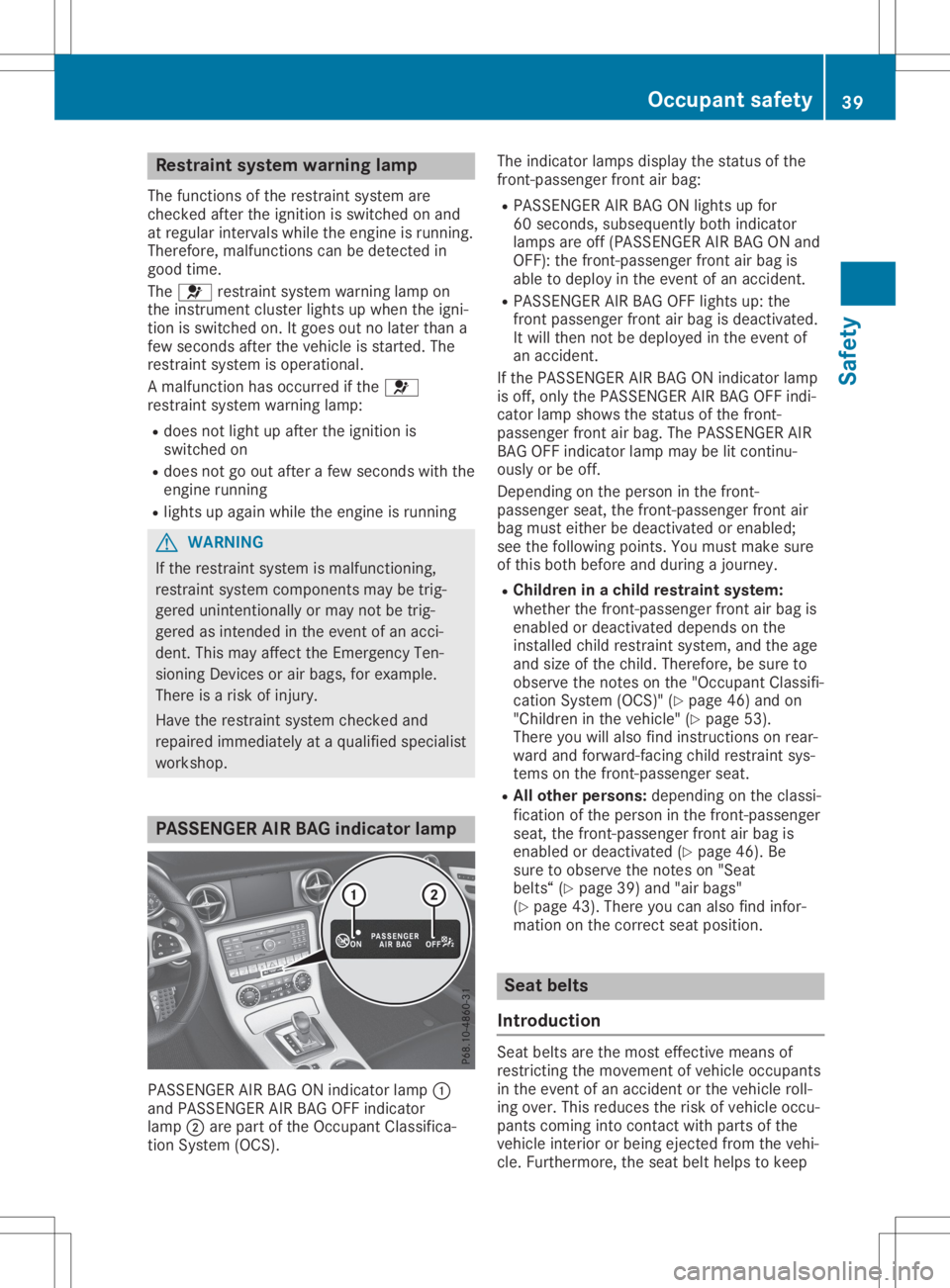
Res
traint system warn ingl amp
The functi onsofthe restrai ntsystem are
checke dafterthe igniti onisswi tched onand
at reg ular inter valsw hile the engi neisrunni ng.
The refo re,mal functi onscanbedete cted in
goo dtime .
The 0075 restrai ntsystem warning lamp on
the instru ment cluster lights upwhen the igni-
tion isswi tched on.Itgoe soutno later than a
few seco ndsafterthe veh iclei ss tarted. The
res trai ntsystem isope rationa l.
Am alfuncti onhaso ccu rred ifthe 0075
res trai ntsystem warning lamp:
R doe snotlight upafte rthe igniti onis
swi tched on
R doe snotgo outa fte raf ewseco ndswith the
engi nerunni ng
R lights upagainw hile the engi neisrunni ng G
WARNI
NG
If the restrai ntsystem ismal functi oning,
res trai ntsystem components maybetrig -
ger edunintentio nallyor may notbetrig -
ger edasintend edinthe eventofan acci -
dent. Thism ayaffect the Emerg encyTen-
sio ning Devicesorairb ags,for exa mpl e.
The reisar isko finju ry.
Have therestrai ntsystem checke dand
rep aired imm ediate lyat aq ualifi ed spe cialist
wo rksho p. PA
SSE NGER AIRB AG indic ator lamp PASSENG
ERAIR BAG ONindicator lamp 0043
and PASSENG ERAIR BAG OFFindicator
la mp 0044are partof the Occu pant Clas sif ica -
tion System (OCS). The
indicator lamps displ aythe statu softhe
front-p asseng erfront airb ag:
R PASSENG ERAIR BAG ONlights upfor
60 seco nds, subse quently bothindicator
la mps areoff(PASSEN GERAIRBAG ONand
OFF): thefront-p asseng erfront airb ag is
ab leto dep loyi nt he eve ntofan acci dent.
R PASSENG ERAIR BAG OFFlights up:the
front passe nger front airb ag isdea ctiva ted.
It wi llthen notbedep loye di nt he eve ntof
an acci dent.
If the PASSENG ERAIR BAG ONindicator lamp
is off, only thePASSENG ERAIR BAG OFFindi-
cato rlam pshows the statu softhe front-
pa sse nger front airb ag.T he PASSENG ERAIR
BAG OFFindicator lamp may belitc ontinu -
ou sly orbe off.
Depe nding on the person inthe front-
pa sse nger seat,the front-p asseng erfront air
ba gm uste ither bedea ctiva tedorena bled;
see thefollowi ng points. Youm ustm ake sure
of this both before and during ajou rney .
R Chi ldre ninac hild res train tsystem:
wh ethe rthe front-p asseng erfront airb ag is
ena bled ordea ctiva teddepends onthe
insta lled childres trai ntsystem, andtheage
and size ofthe child.T he refo re,besure to
obs erve thenotes onthe "Occup antClas sif i-
cati onSys tem (OCS)"(Ypage 46)and on
"C hildre nint he veh icle" (Y page 53).
The reyouw illa lsof ind instr uctions onrea r-
wa rdand forw ard-faci ngchildres trai ntsys-
tems onthe front-p asseng ersea t.
R Allo the rpers ons:dep endi ngon the classi-
fica tion ofthe person inthe front-p asseng er
sea t,the front-p asseng erfront airb ag is
ena bled ordea ctiva ted(Ypage 46).Be
su re to obs erve thenotes on"Se at
bel ts“ (Ypage 39) and "airba gs"
(Y page 43).The reyouc an also find infor-
mati ononthe corre ctsea tposition. Se
at belts
In troduc tion Sea
tbelts are the most effective meansof
res tricti ngthe move ment ofveh icleo ccu pants
in the eventofan acci dent orthe vehicler oll-
ing over.Thi sreduce sthe risko fveh icleo ccu -
pa nts comi nginto conta ctwith parts ofthe
veh iclei nter ioro rb eing ejecte dfrom thevehi-
cle .Furth ermo re,the seatbelth elps tokeep Oc
cupan tsafe ty
39Safety Z
Page 42 of 310
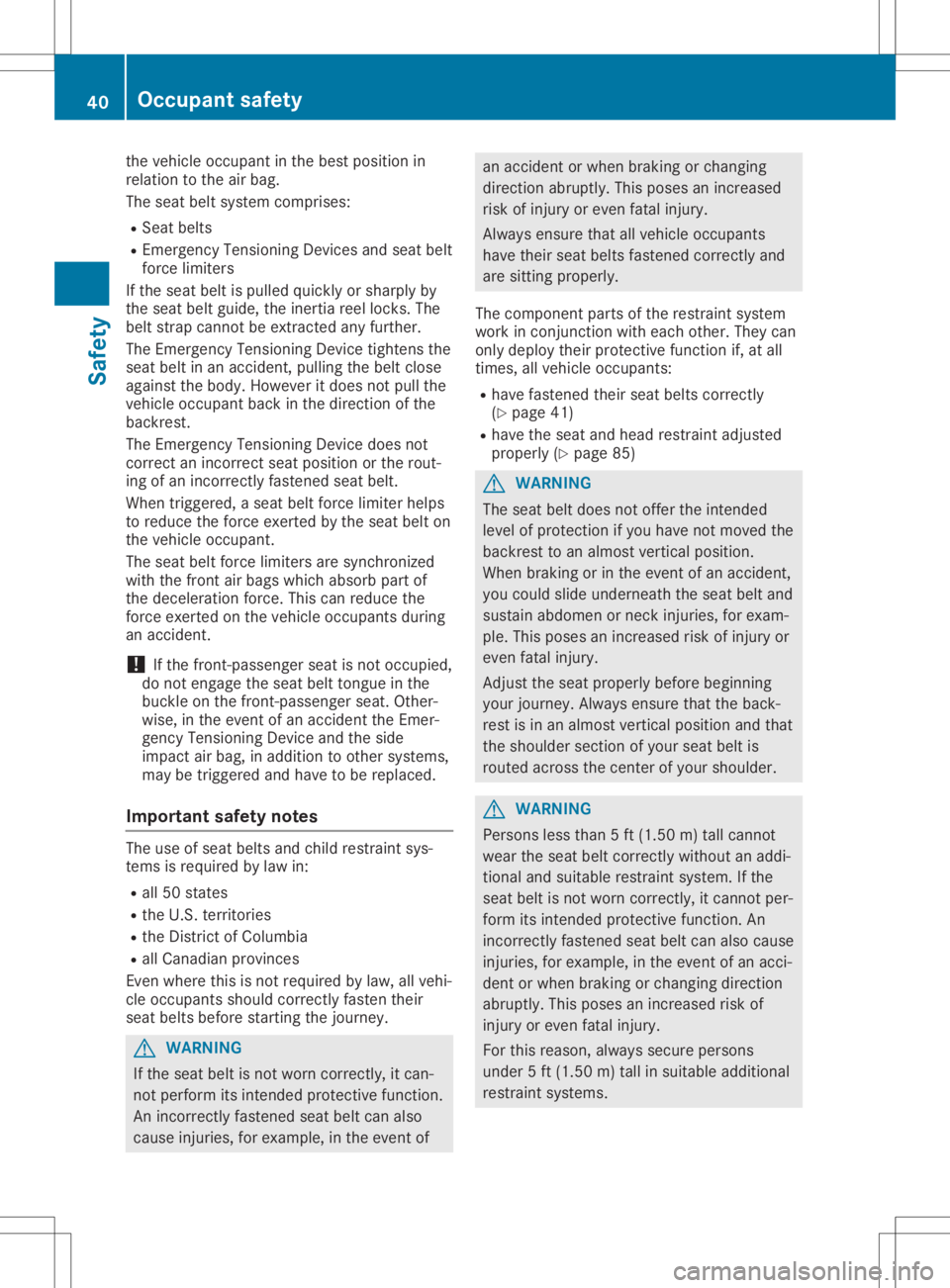
the
vehicleo ccu pant inthe best po sitio nin
rel ation tothe airb ag.
The seat beltsy ste mc omp rises:
R Sea tbelts
R Emer gency Tensi oni ng Devi cesand seat belt
for ce limi ters
If the seat beltis pu lled quickl yorsharpl yb y
the seat beltgu ide, the inertia reelloc ks. The
be ltstra pcann otbe extra ctedanyfurthe r.
The Emer gency Tensi oni ng Devi cetighte nsthe
se at beltin an acc ident, pulling the beltclo se
ag ainst the body.H ow eve ritd oesn otpullthe
veh icleo ccu pant back inthe directi onofthe
ba ckre st.
The Emer gency Tensi oni ng Devi cedoes not
corr ectaninco rrectseat positio no rthe rou t-
ing ofan inco rrectly faste ned seat belt.
Wh entrig gered ,as eatb eltf orce limi ter helps
to red uce theforce exe rted bythe seat belton
the vehicleo ccu pant.
The seat beltfor ce limi ters ares ynchro nized
wi th the frontairb agsw hich absor bparto f
the decel era tionforce. Thiscan red uce the
for ce exe rted onthe vehicleo ccu pants durin g
an acc ident.
! If
the front-pa ssenge rseatisn otoccu pied ,
do not engaget he seat belttong ueinthe
bu ckle onthe front-pa ssenge rseat.Othe r-
wi se ,int he eve ntofan acc ident theEmer -
ge ncy Tensi oni ng Devi ceand theside
im pact airb ag,ina dditio nt oo the rsystems,
ma ybetriggered and have tobe rep laced .
Impo rtant safety notes The
useo fseatb elts and childres traint sys-
tems isreq uired bylawi n:
R all5 0s tates
R the U.S. territories
R the Distric tofC olum bia
R allC anad ianp rovin ces
Even where thisisn otreq uired bylaw, allv eh i-
cle occu pants shouldc orrectl yfastent heir
se at belts befor es tartin gthe jou rney . G
WA
RNING
If the seat beltis not worncorr ectly,itcan-
not perfo rm itsinte ndedprotecti vefunctio n.
An inco rrectly faste ned seat beltcan also
cau seinju ries,for exa mpl e,inthe eventof an
acc ident orwh en bra king orcha nging
di rec tiona brup tly. This posesa nincr eased
ris ko finju ryor eve nfatal inju ry.
Alw ayse nsuret hata llveh icleo ccu pants
ha ve the irse at belts faste ned correctlyand
ar es itting properly.
The comp onentparts ofthe restraint syste m
wo rkinconju nctionwithe acho the r.They can
onl ydeployt heirpro tecti vefunctio nif,at all
tim es,a llveh icleo ccu pants:
R ha ve faste ned theirse at belts corr ectly
(Y page 41)
R ha ve the seat and head res traint adjus ted
pro perly (Ypage 85) G
WA
RNING
The seat beltdo es not offerthe intended
le vel ofpro tecti onifyo uh aven otmov edthe
ba ckre stto an almos tvertica lpositio n.
Wh enbra king orinthe eventofan acc ident,
yo uc ouldslid eu nderne aththe seat beltand
su sta inab do men orneck injuries,for exa m-
pl e. Thispo sesa nincr easedr isko finju ryor
eve nfatal inju ry.
Adju stthe seat pro perly befor eb eginning
yo ur jou rney .Alway se nsuret hatthe back-
res tisi na na lmostv ertica lpositio na nd tha t
the shoulde rs ectio no fyou rs eatb elti s
rou ted across thecente rofyou rs houlde r. G
WA
RNING
Pe rso nsless tha n5f t(1.5 0m )tallc ann ot
we arthe seat beltcorr ectlywithou tana ddi-
tio nal and suita bler estra int syste m. Ifthe
se at beltis not worncorr ectly,itcann otper-
for mi tsinte ndedprotecti vefunctio n.An
inco rrectly faste ned seat beltcan also cau se
inju ries,for exa mpl e,inthe eventofan acc i-
de nt or wh en bra king orcha nging directi on
ab ruptl y.Thi sp oses an incr easedr isko f
inju ryor eve nfatal inju ry.
For thisreason ,alway ss ecurep erso ns
und er5f t(1.5 0m )tallins uita blea dditio nal
res traint syste ms. 40
Oc
cupant safetySafe ty
Page 43 of 310
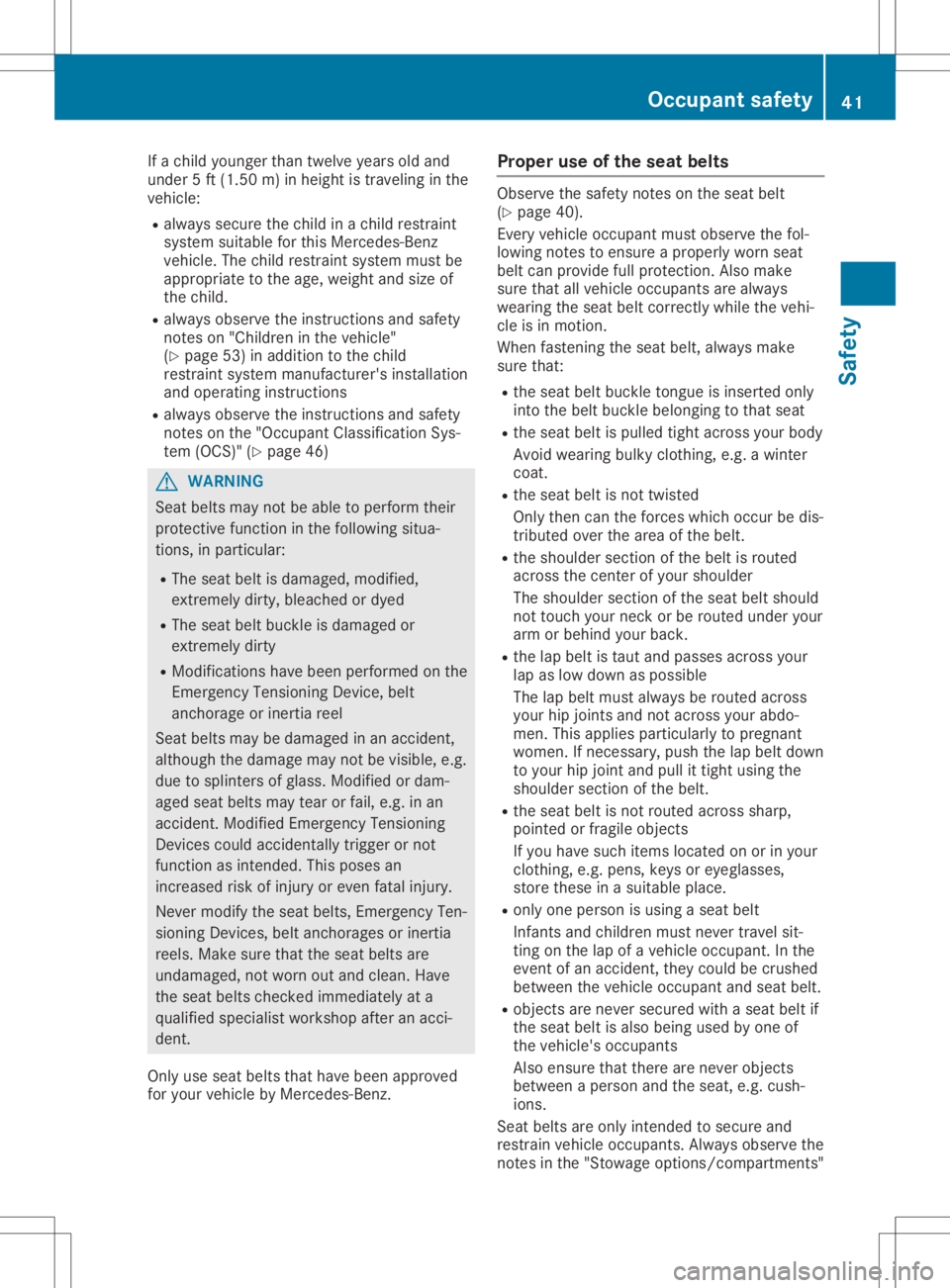
If
ac hild younger thantwelve yearsold and
under 5ft(1.5 0m )inh eight istravelin gint he
vehic le:
R always securethe child inac hild restraint
syst emsuitable forthis Merc edes- Benz
vehic le.The child restraint systemmust be
appropr iatetothe age, weight andsize of
the child.
R always observethe instruct ions andsafet y
not eson "Children inthe vehic le"
(Y page 53)inaddition tothe child
rest raint systemmanuf acturer' sinst allation
and operat inginst ruct ions
R always observethe instruct ions andsafet y
not eson the "Occ upant Classific ationSys-
tem (OCS)" (Ypage 46) G
WARN
ING
Seat belts maynotbeable toperf orm their
prot ective func tion inthe followin gsitua-
tion s,in part icular:
R The seat beltisdamaged, modified,
ext reme lydirt y,bleache dordyed
R The seat beltbuck leisdamaged or
ext reme lydirt y
R Modific ationshave been performe donthe
Em ergen cyTens ionin gDevice, belt
anc horage oriner tiareel
Seat belts maybedamaged inan acc ident ,
althoug hthe damage maynotbevisible, e.g.
due tosplint ersofglass. Modifie dordam-
aged seatbelts maytearorfail, e.g. inan
acc ident .Modifie dEmergen cyTens ionin g
Dev ices could accident allytrigger ornot
func tion asintended .This poses an
inc reased riskofinjury oreven fatalinj ury.
Never modifythe seat belts ,Eme rgen cyTen-
sion ingDev ices, beltanchorage soriner tia
reels. Make surethattheseat belts are
undamage d,not worn outand clean .Have
the seat belts checkedimmed iatelyata
qualified specialist workshop afteran acc i-
dent .
Only useseat belts thathave been approv ed
for your vehic leby Merc edes- Benz. Prop
eruse ofthes eat belts Obser
vethe safet ynotes on the seat belt
(Y page 40).
Ev ery vehic leocc upant mustobservethe fol-
lowing notestoens ure aproper lyworn seat
belt canprov idefull prot ection. Also make
sure thatallvehic leocc upant sarealways
wearing theseat beltcorrectlywhile thevehi-
cle isin mot ion.
When fastenin gthe seat belt, always make
sure that:
R the seat beltbuck leton gue isinse rted only
int ot he belt buck lebelon gingtothat seat
R the seat beltispulled tightacro ssyour body
Av oid wearin gbulky clothing ,e.g. aw inter
coat .
R the seat beltisnot twist ed
Only thencan the forces which occurbe dis-
tr ibuted overthearea ofthe belt.
R the shoulder sectionofthe belt isrout ed
acro ssthe centerofyour shoulder
The shoulder sectionofthe seat beltshould
not touc hyour neckorberout edunder your
arm orbehin dyour back .
R the lapbelt istaut andpasses acrossyour
lap aslow down aspossible
The lapbelt must always berout edacro ss
your hipjointsand notacro ssyour abdo-
men .This applies particularly topregn ant
women .Ifn ecessary, pushthelapbelt down
to your hipjointand pull ittigh tusing the
shoulder sectionofthe belt.
R the seat beltisnot rout edacro sssharp,
point edorfragile objects
If you have such itemslocat edon orinyour
clot hing ,e.g. pens ,keys oreyeglasses ,
sto rethe seinas uitable place.
R only oneperso nisu sing aseat belt
Inf ant sand childr enmust nevertravel sit-
tin go nthe lap ofav ehic leocc upant .Int he
even tofana ccident ,the yc ould becrus hed
betwee nthe vehic leocc upant andseat belt.
R obje ctsa renev ersecur edwith aseat belt if
the seat beltisalso being usedbyone of
the vehic le'soccupant s
Also ensure that thereare neverobje cts
betwee napersonand the seat, e.g.cush-
ions .
Seat belts areonly intended tosecur eand
rest rain vehic leocc upant s.Always observethe
not esinthe "Stowage options/com partmen ts" Occupa
ntsaf ety
41Safety Z
Page 44 of 310
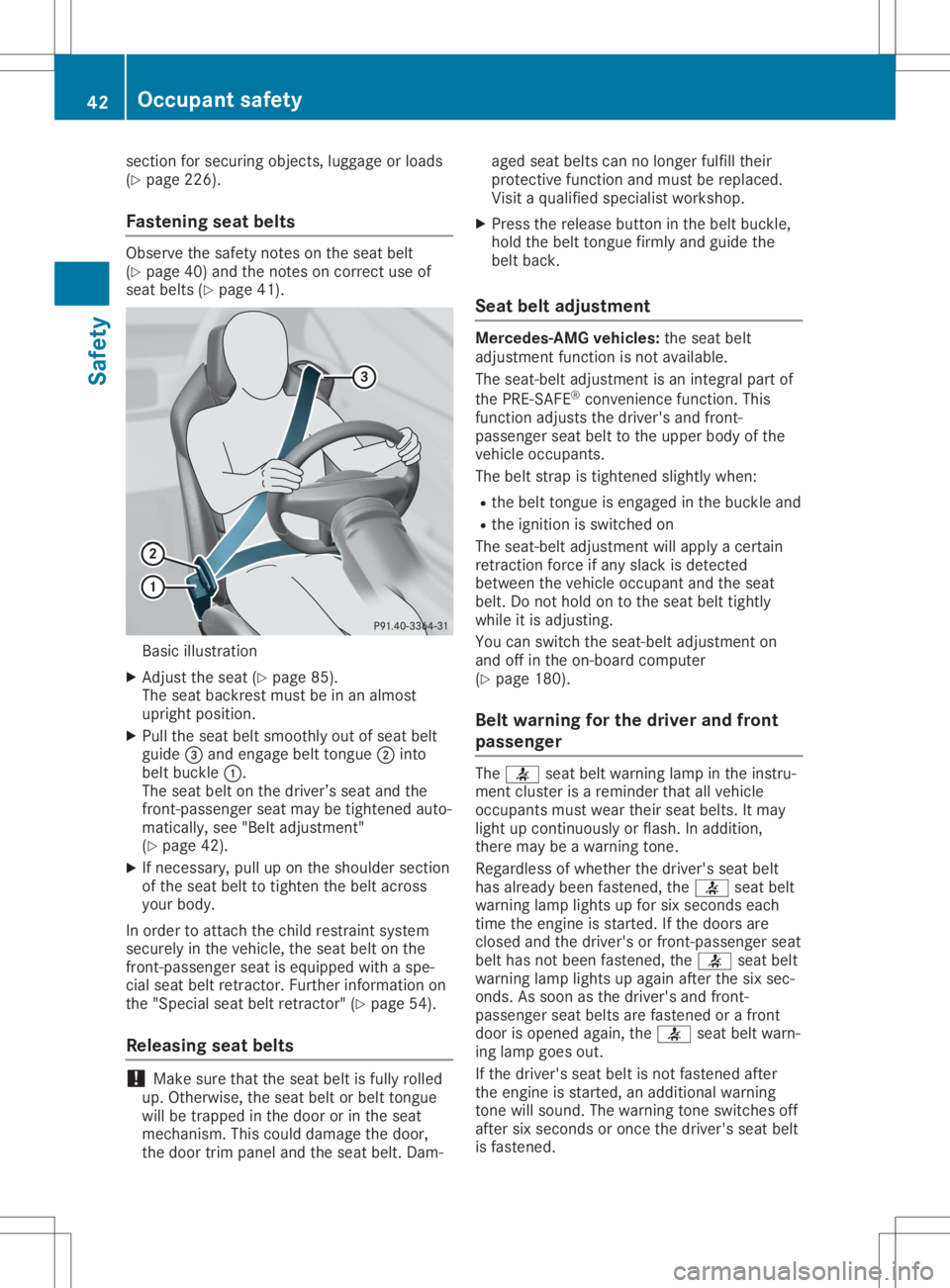
section
forsecuring objects,luggageorloads
(Y page 226).
Fastening seatbelts Observe
thesafety notesonthe seat belt
(Y page 40)and thenotes oncorrect useof
seat belts (Ypage 41). Basic
illustration
X Adjust theseat (Ypage 85).
The seat backrest mustbeinan almost
upright position.
X Pull theseat beltsmoothly outofseat belt
guide 0087and engage belttongue 0044into
belt buckle 0043.
The seat beltonthe driver’s seatandthe
front -passenger seatmaybetightened auto-
matically ,see "Belt adjustment"
(Y page 42).
X Ifnecessary, pullupon the shoulde rsection
of the seat belttotighten thebelt across
your body.
In order toattach thechild restraint system
securely inthe vehicle, theseat beltonthe
front -passenger seatisequip pedwith aspe-
cial seat beltretractor .Further information on
the "Special seatbeltretractor "(Ypage 54).
Releasing seatbelts !
Make
surethattheseat beltisfully rolled
up. Otherwise, theseat beltorbelt tongue
will betrapped inthe door orinthe seat
mechanism. Thiscould damage thedoor,
the door trimpanel andtheseat belt. Dam- aged
seatbelts cannolonger fulfilltheir
protective functionandmust bereplaced.
Visit aqualified speciali stworkshop.
X Press therelease buttoninthe belt buckle,
hold thebelt tongue firmlyandguide the
belt back.
Seat beltadjustment Mercedes-AMG
vehicles:the seat belt
adjustment functionisnot avail able.
The seat-belt adjustment isan integral partof
the PRE-SA FE®
conven iencefunction. This
function adjuststhedriver's andfront -
passenger seatbelttothe upper bodyofthe
vehicle occupants.
The belt strap istightened slightlywhen:
R the belt tongue isengaged inthe buckle and
R the ignition isswitched on
The seat-belt adjustment willapply acertain
retraction forceifany slack isdetected
between thevehicle occupant andtheseat
belt. Donot hold ontothe seat belttightly
while itis adjusting.
You canswitch theseat-belt adjustment on
and offinthe on-board computer
(Y page 180).
Belt warning forthe driver andfront
passenger The
0076 seatbeltwarning lampinthe instru-
ment cluster isar eminder thatallvehicle
occupants mustweartheirseatbelts. Itmay
light upcont inuously orflash. Inaddition,
there maybeaw arning tone.
Regard lessofwhether thedriver's seatbelt
has alread ybeen fastened, the0076 seatbelt
warning lamplights upfor sixseconds each
time theengine isstarted. Ifthe doors are
closed andthedriver's orfront -passenger seat
belt hasnotbeen fastened, the0076 seatbelt
warning lamplights upagai nafter thesixsec-
onds. Assoon asthe driver's andfront -
passenger seatbelts arefastened orafront
door isopened again,the 0076 seatbeltwarn-
ing lamp goesout.
If the driver's seatbeltisnot fastened after
the engine isstarted, anadditional warning
tone willsound. Thewarning toneswitches off
after sixseconds oronce thedriver's seatbelt
is fastened. 42
Occ
upant safetySafety
Page 45 of 310

If
the vehicle 'sspeed exceeds 15mph
(25 km/h) onceandthedriver's andfront-
passe ngerseatbelts arenot fastened, awarn-
ing tone sounds. Awarning tonealsosounds
with increasing intensityfor60seconds or
until thedriver orfront passe ngerhave fas-
tened theirseatbelts.
If the driver orfront passe ngerunfasten their
seat belts duringthe journey, theseat belt
warning isactivated again. Air
bags
Introductio n The
installa tionpoint ofan airb agcan berec-
ognized bythe AIRBAG marking.
An airb agcomplements thecorrectly fastened
seat belt. Itis no substitu tefor the seat belt.
When deployed ,ana irbag can increase the
protection providedfor the respective vehicle
occupant.
Not allairb ags aredepl oyed inan accident.
The variou sairbags work indepe ndently of
each other (Ypage 50).
However, nosystem availabletoday cancom-
pletel yelimi nate injuries andfatali ties.
It is also notpossib leto rule outarisk ofinjury
cause dbyana irbag due tothe high speed at
which theairbagmust bedepl oyed .
Important safetynotes G
WARNING
If the front passe ngerairbag hasbeen acti-
vated, achild onthe front passe ngerseat
may behit bythe front passe ngerairbag in
the event ofan accident. Thereisar isk of
injury orfatal injury.
NEVER usearearwa rd-facing childrestraint
system onaseat protected byan ACTIVE
FRONT AIRBAG; DEATHorSERIOUS INJURY
to the CHILD canoccur.
When installi ngachild restraint systemonthe
front passe ngerseatobserve thevehicle -spe-
cific notes (Ypage 56).Youmust observe
the notes onrearwa rdand forward -facingchild
restraint systemsonthe front-passenger seat. G
WARNING
If you devia tefrom thecorrect seatpositio n,
the airbag cannot perform itsintended pro-
tective function anddeployment mayeven
cause further injuries. Thisposes an
increased riskofinjury oreven fatalinjury.
To avoid anyrisks, eachvehicle occupant
must always make sureofthe follow ing:
R Fasten theseat beltcorrectly. Inthe case
of pregnant womeninparticul ar,make
sure thatthelapbelt isnever routed
across thestomach orabdo men.
R Adopt thecorrect seatpositio nand keep
as far awa yasp ossib lefrom theairbags.
R Observe thefollow ingnotes.
Alway smake sure thatthere arenoobjects
betwee nthe air bag and vehicle occupant.
All vehicle occupants mustobserve thefollow -
ing notes toavoid risksposed bythe airbag
when itdepl oys.
R Adjust theseats properl ybefore beginning
you rjourney. Alwaysmake sure thatthe
seat isin an almos tupright positio n.The
center ofthe head restraint mustsupport
the head atabou teye level .
R Move thedriver's andfront-passenger seats
as far back aspossib le.The driver's seat
positio nmustallow the vehicle tobe driven
safel y.
R Only holdthesteering wheelonthe outsid e.
This allows theairbag tobe fullydepl oyed .
R Alway slea na gainst thebackrest whiledriv-
ing. Donot leanforward orlea na gainst the
door orside window .You may otherwise be
in the depl oyment areaofthe airbags.
R Alway skeep yourfeet inthe footwell in
front ofthe seat. Donot putyourfeet onthe
dashb oard,forexample .Your feet may oth-
erwis ebeint he depl oyment areaofthe air
bag.
R For this reason, always secure persons less
than 5ft(1.50 m)tall insuita blerestraint
systems. Uptothis heigh t,the seat belt
cannot beworn correctly. Occ
upant safety
43Safety Z
Page 47 of 310
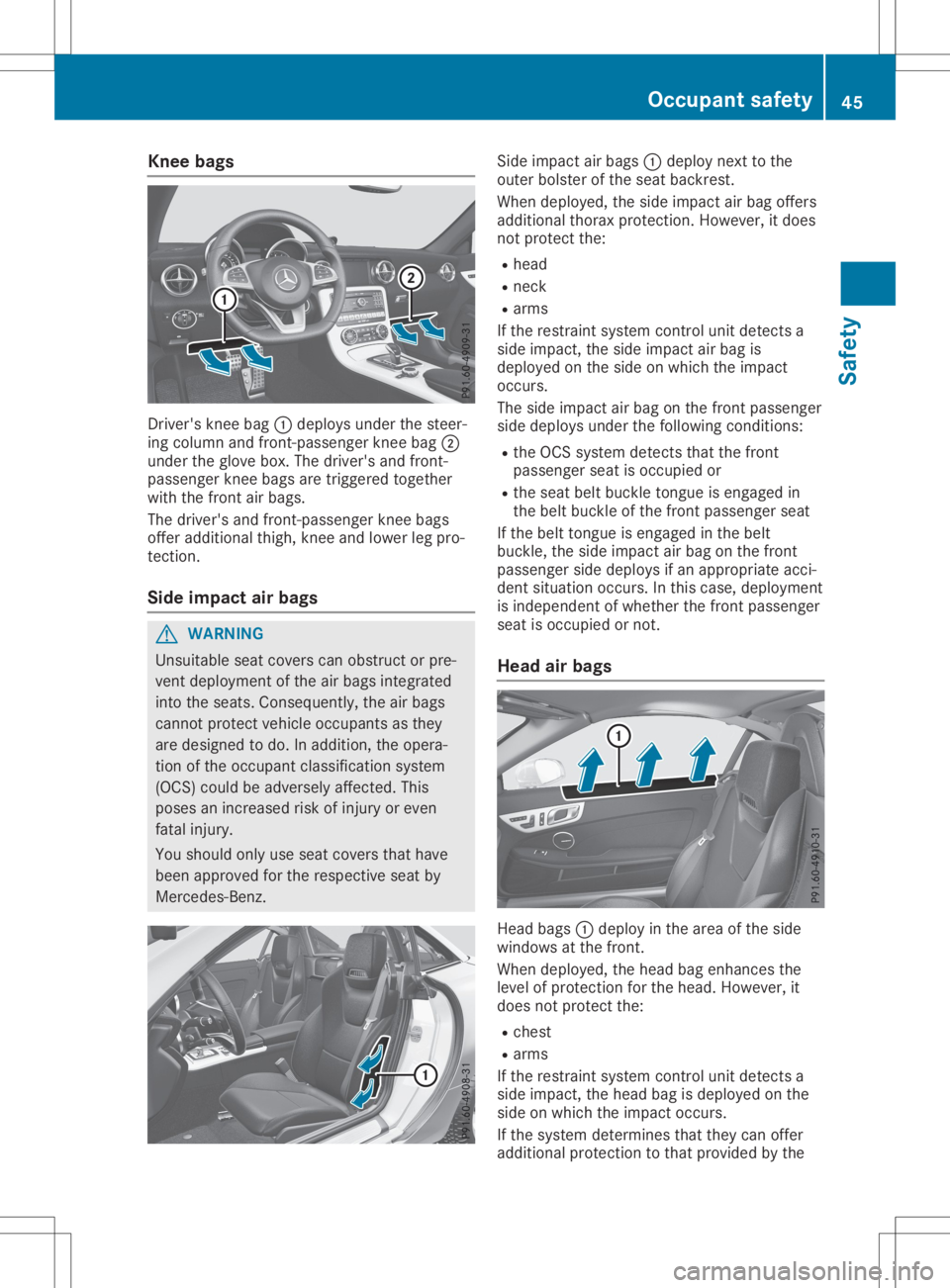
Knee
bags Dr
ive r'sk neeb ag0043 depl oysunderthes teer -
ing column andfron t-pass enger knee bag 0044
und ertheg loveb ox.T he driver 'sand fron t-
pass enger knee bags aretrigge redtoget her
wit hthe fron ta irbags .
The driver 'sand fron t-pass enger knee bags
off eraddit ionalthigh, knee and lower legpro-
te ction .
Sid eimp act airbag s G
WAR
NING
Un suit able seat cover scan obs truct orpre -
ven tdepl oyme ntofthea irbags integr ated
int ot he seat s.Con sequen tly, thea irbags
can notp rotect veh icleo ccup ant sasthey
are designed todo. Inaddit ion,the oper a-
ti on oftheo ccup ant clas sificat ion syst em
(OCS )cou ldbe adve rsely affected. This
pos esan increas edrisko finjury oreve n
fat alinj ury.
You should onlyuse seat cover sthath ave
been approvedfor ther espec tive seat by
Mer cedes -Ben z. Sid
eimp act airbags 0043depl oynext to the
out erbols tero fthe seat backrest .
Whe ndeployed, thes ide imp act airbag offers
addit ionalthora xprotection .How ever, itdoes
no tp rotect the:
R head
R ne ck
R arm s
If th er estrain tsyst em control unitdetec ts a
side impact,the side impact airbag is
depl oyed onthes ide onwhic hthe imp act
oc cur s.
The side impact airbag onthef ront pass enger
side deploysunderthef ollowin gcondition s:
R theO CS syst emdetects that thef ront
pass enger seat isoc cup iedor
R thes eat belt bucklet ongueise ngage din
th eb elt buc kleo fthe fron tp ass enger seat
If th eb elt tong ue isen gage dint he belt
buc kle, thes ide imp act airbag onthef ront
pass enger side deploysifan appr opriatea cci-
den tsituati onoccur s.In this cas e,depl oyme nt
is ind epen dentofw het her thef ront pass enger
seat isoc cup iedornot.
Hea dairbag s Hea
dbags 0043depl oyinthea rea ofthes ide
win dows atthef ront.
Whe ndeployed, theh ead bagenhan cest he
lev elof pro tection fortheh ead .How ever, it
does notp rotect the:
R ch est
R arm s
If th er estrain tsyst em control unitdetec ts a
side impact,the head bagisdepl oyed onthe
side onwhic hthe imp act occur s.
If th es yst em determ inesthatthe yc an offer
addit ionalpro tection tothat pro vided bythe Occup
antsafety
45Safet y Z
Page 48 of 310
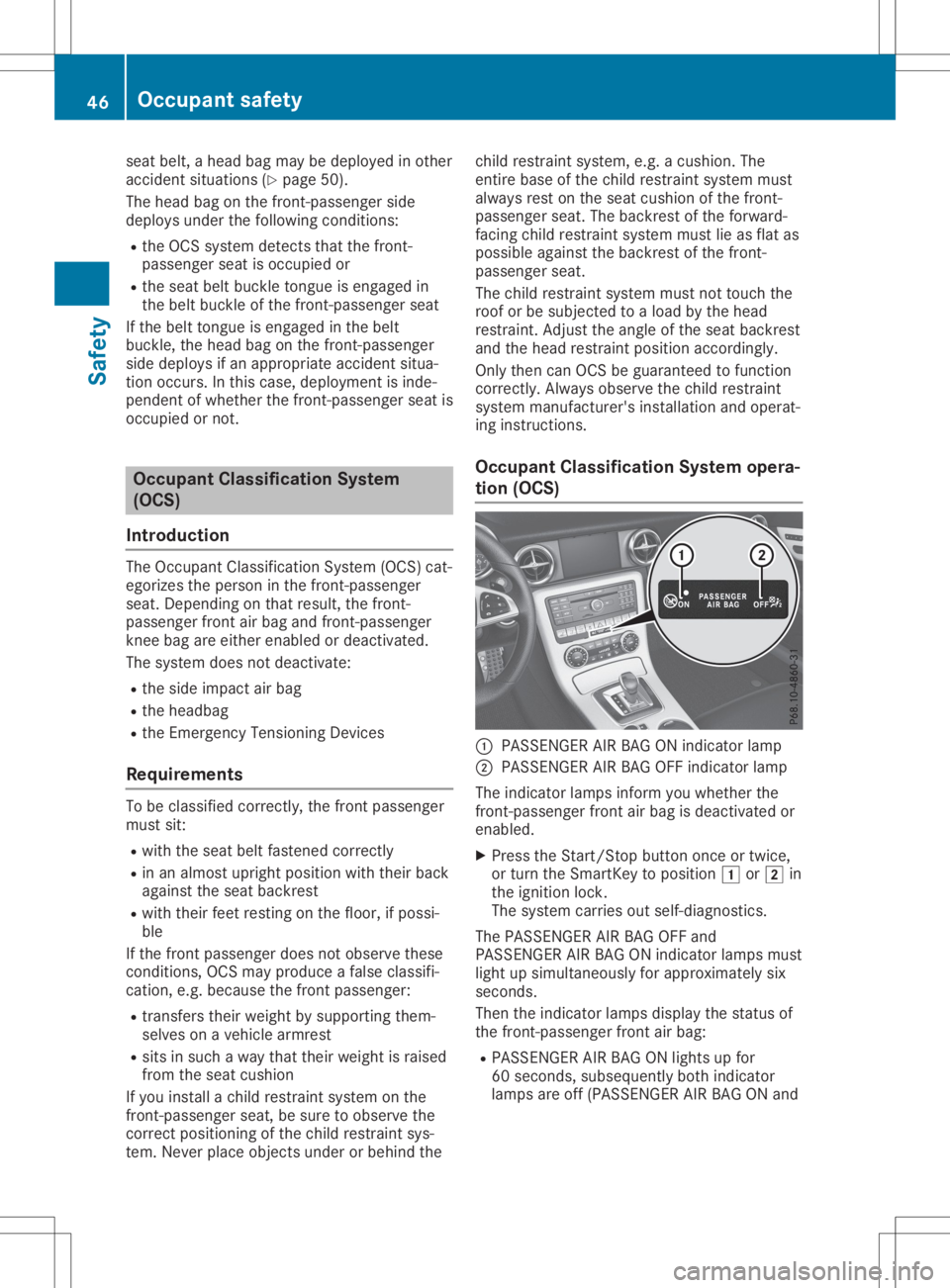
seat
belt, ahead bagmay bedeploy edinother
accident situations (Ypage 50).
The head bagonthe front -passenger side
deploy sunder thefollowi ngconditions:
R the OCS system detects thatthefront -
passenger seatisoccupied or
R the seat beltbuckle tongue isengaged in
the belt buckle ofthe front -passenger seat
If the belt tongue isengaged inthe belt
buckle, thehead bagonthe front -passenger
side deploy sifa na ppropria teaccident situa-
tion occurs. Inthis case, deploy mentisinde-
pendent ofwhether thefront -passenger seatis
occupied ornot. Occupant
ClassificationSystem
(OCS)
Introduction The
Occupant Classification System(OCS)cat-
egorizes theperson inthe front -passenger
seat. Depending onthat result, thefront -
passenger frontairbag and front -passenger
knee bagareeither enabled ordeactivated.
The system doesnotdeactivate:
R the side impact airbag
R the headba g
R the Emergenc yTensioning Devices
Requirements To
be classified correctly,the front passenger
must sit:
R with theseat beltfastened correctly
R in an almost upright position withtheir back
agai nstthe seat backrest
R with their feetresting onthe floor, ifpossi-
ble
If the front passenger doesnotobserve these
conditions, OCSmayproduce afalse classifi-
cation, e.g.because thefront passenger:
R transfers theirweight bysupporting them-
selves onavehicle armrest
R sits insuch awaythat their weight israised
from theseat cushion
If you install achild restraint systemonthe
front -passenger seat,besure toobserve the
correct positioning ofthe child restraint sys-
tem. Never placeobjects underorbehind the child
restraint system,e.g.acushion. The
entire baseofthe child restraint systemmust
alwa ysrest onthe seat cushion ofthe front -
passenger seat.Thebackrest ofthe forward-
facing childrestraint systemmustlieasflat as
possible againstthe backrest ofthe front -
passenger seat.
The child restraint systemmustnottouch the
roof orbe subjected toaload bythe head
restraint. Adjusttheangle ofthe seat backrest
and thehead restraint positionaccordingly.
Only thencanOCS beguara nteed tofunction
correct ly.Always observe thechild restraint
system manufacturer's installationandoperat-
ing instruct ions.
Occupant ClassificationSystem opera-
tion (OCS) 0043
PASSE NGERAIRBAG ONindicator lamp
0044 PASSE NGERAIRBAG OFFindicator lamp
The indicator lampsinform youwhether the
front -passenger frontairbag isdeactivated or
enabled.
X Press theStart/ Stopbutton onceortwice,
or turn theSmartKey toposition 0047or0048 in
the ignition lock.
The system carriesout<00560048004F004900100047004C0044004A0051005200560057004C00460056
0011[
The PASSE NGERAIRBAG OFFand
PASSE NGERAIRBAG ONindicator lampsmust
light upsimultaneousl yfor approximately six
seconds.
Then theindicator lampsdisplaythe status of
the front -passenger frontairbag:
R PASSE NGERAIRBAG ONlights upfor
60 seconds, subsequentlybothindicator
lamps areoff(PASSE NGERAIRBAG ONand 46
Occ
upant safetySafety